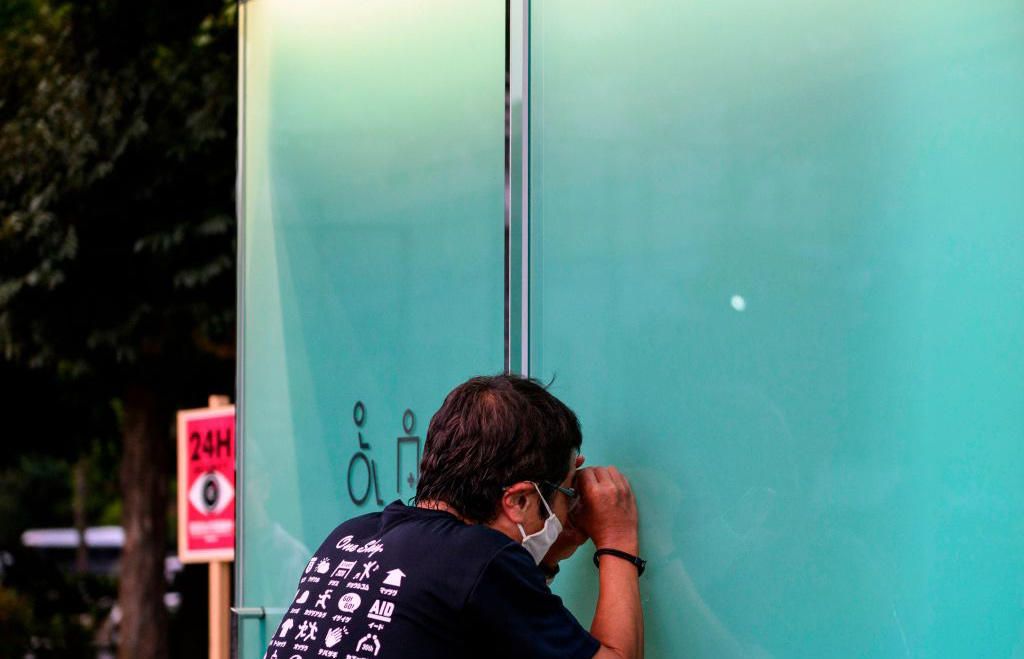东京街头的透明公共厕所,你敢用吗?

曾经获得普利兹克奖的日本建筑师坂茂(Shigeru Ban)在业界已经小有名气,他主要设计游客中心、博物馆、公寓和时尚风格的私人住宅。此外,他还为地震、洪水和战争设计应急避难所。今年,为了配合已经被推迟的东京奥运会,受一家日本基金会的委托,坂茂参与了东京公共厕所群的建造——听起来有些大材小用,但请接着往下看。
这一赛事的结果于8月5日在涩谷区Yoyogi公园附近的两个地点公布,同时也吸引了全球的关注。原因在于坂茂设计的洗手间是灯火通明的彩色玻璃盒子,完全透明,或者至少一开始看起来是这样。这些建筑是由“智能玻璃”制成的,当使用者进入并锁上门后,这些玻璃会变得不透明。
坂茂称这些建筑为“Tomei厕所”(Tomei在日语中是“透明”的意思)。在他看来,这个设计解答了人人都会在上公共厕所时担心的问题:厕所干净吗?是不是已经有人在里面了?
到了晚上,厕所设施会像“一盏美丽的灯笼”一样散发着光亮。

坂茂设计的发光厕所是“东京厕所项目”(Tokyo Toilet Project)的一部分,该项目位于涉谷,由17个公共厕所组成,由日本基金会(Nippon Foundation)委托设计。日本基金会是摩托艇赛巨头笹川良一(Ryoichi Sasakawa)创立的慈善组织。参与这项工作的其他设计者也都是日本建筑界和设计界的佼佼者:安藤忠雄、藤本壮介、伊东丰雄、片山正通、隈研吾、槙文彦、田村奈惠和佐藤可士和。
大家都知道日本人注重清洁和个人卫生。《卫报》(Guardian)的贾斯汀•麦柯里指出,日本的高科技厕所长期以来一直吸引着外国游客,但有时也让游客们摸不着头脑。在新冠肺炎疫情爆发之前,日本最大的马桶生产商Toto公司生产的高档卫浴产品,几乎是中国游客赴日旅游时的“必购之物”。
但这次,将为涉谷新厕所的设施维护买单的日本基金会表示,他们希望消除公众对公厕“黑暗、肮脏、难闻”的误解。基金会称其目标是利用先进的设计创造出“无论性别、年龄、是否残疾,人人都可以使用的公共厕所”。他们想借此阐释:包容性社会的达成,是有可能的。
当然,在艺术方面,这些厕所也能够让游客感到极度舒适。安藤忠雄为Jingu Dori公园设计的厕所,带有一个倾斜屋顶的圆形结构,可以作为咖啡馆或奢侈品精品店使用。槙文彦为East Ebisu公园设计的厕所则带有一个室内庭院和造型优美的弧形白色屋顶,看起来就像是一个艺术画廊。
把这样的创造力“浪费”在马桶和厕所上,有意义吗?也许确实没有什么意义。但是,公共厕所从人类文明开始就一直是人们设计的焦点——从某种意义上说,厕所是文明社会的标志之一。提供一个有趣的事实:已知最早的复杂污水系统连接多个抽水马桶的例子,出现在印度河流域的哈拉帕和摩亨佐-达罗古城,可以追溯至公元前3世纪中期。而将巧妙、伟大的设计应用到这样一种最日常的人类需求中,何尝不是一种众生平等的体现呢?
(说回东京的透明厕所吧。)到目前为止,其中的7座厕所已经建成,剩下的10座预计将在未来几个月内开放。(财富中文网)
编译:杨二一
曾经获得普利兹克奖的日本建筑师坂茂(Shigeru Ban)在业界已经小有名气,他主要设计游客中心、博物馆、公寓和时尚风格的私人住宅。此外,他还为地震、洪水和战争设计应急避难所。今年,为了配合已经被推迟的东京奥运会,受一家日本基金会的委托,坂茂参与了东京公共厕所群的建造——听起来有些大材小用,但请接着往下看。
这一赛事的结果于8月5日在涩谷区Yoyogi公园附近的两个地点公布,同时也吸引了全球的关注。原因在于坂茂设计的洗手间是灯火通明的彩色玻璃盒子,完全透明,或者至少一开始看起来是这样。这些建筑是由“智能玻璃”制成的,当使用者进入并锁上门后,这些玻璃会变得不透明。
坂茂称这些建筑为“Tomei厕所”(Tomei在日语中是“透明”的意思)。在他看来,这个设计解答了人人都会在上公共厕所时担心的问题:厕所干净吗?是不是已经有人在里面了?
到了晚上,厕所设施会像“一盏美丽的灯笼”一样散发着光亮。
坂茂设计的发光厕所是“东京厕所项目”(Tokyo Toilet Project)的一部分,该项目位于涉谷,由17个公共厕所组成,由日本基金会(Nippon Foundation)委托设计。日本基金会是摩托艇赛巨头笹川良一(Ryoichi Sasakawa)创立的慈善组织。参与这项工作的其他设计者也都是日本建筑界和设计界的佼佼者:安藤忠雄、藤本壮介、伊东丰雄、片山正通、隈研吾、槙文彦、田村奈惠和佐藤可士和。
大家都知道日本人注重清洁和个人卫生。《卫报》(Guardian)的贾斯汀•麦柯里指出,日本的高科技厕所长期以来一直吸引着外国游客,但有时也让游客们摸不着头脑。在新冠肺炎疫情爆发之前,日本最大的马桶生产商Toto公司生产的高档卫浴产品,几乎是中国游客赴日旅游时的“必购之物”。
但这次,将为涉谷新厕所的设施维护买单的日本基金会表示,他们希望消除公众对公厕“黑暗、肮脏、难闻”的误解。基金会称其目标是利用先进的设计创造出“无论性别、年龄、是否残疾,人人都可以使用的公共厕所”。他们想借此阐释:包容性社会的达成,是有可能的。
当然,在艺术方面,这些厕所也能够让游客感到极度舒适。安藤忠雄为Jingu Dori公园设计的厕所,带有一个倾斜屋顶的圆形结构,可以作为咖啡馆或奢侈品精品店使用。槙文彦为East Ebisu公园设计的厕所则带有一个室内庭院和造型优美的弧形白色屋顶,看起来就像是一个艺术画廊。
把这样的创造力“浪费”在马桶和厕所上,有意义吗?也许确实没有什么意义。但是,公共厕所从人类文明开始就一直是人们设计的焦点——从某种意义上说,厕所是文明社会的标志之一。提供一个有趣的事实:已知最早的复杂污水系统连接多个抽水马桶的例子,出现在印度河流域的哈拉帕和摩亨佐-达罗古城,可以追溯至公元前3世纪中期。而将巧妙、伟大的设计应用到这样一种最日常的人类需求中,何尝不是一种众生平等的体现呢?
(说回东京的透明厕所吧。)到目前为止,其中的7座厕所已经建成,剩下的10座预计将在未来几个月内开放。(财富中文网)
编译:杨二一
Shigeru Ban, the Pritzker Prize-winning Japanese architect, is renowned as a designer of visitor centers, museums, condominiums, and stylish private residences. He also is acclaimed for his work as a designer of emergency shelters for victims of earthquakes, floods, and war. This year, in conjunction with the now-postponed Tokyo Olympic Games, a Japanese foundation commissioned Ban to apply his prodigious talents to the creation of a lowlier structure: public toilets.
The result, unveiled August 5 in two locations near Shibuya ward's Yoyogi Park, is attracting global attention. The reason? Ban's restrooms are brightly lit boxes of colored glass—and completely transparent. Or at least they seem to be at first. The structures are fashioned from "smart glass" that renders them opaque after a user enters and locks the door.
Ban calls these structures "tomei toilets." (Tomei is the Japanese word for "see-through.") He says the design presented itself to him as the obvious solution to two questions everyone worries about when using a public toilet: Is it clean? And is it already occupied?
At night, the facilities radiate light "like a beautiful lantern."
Ban's glowing boxes are part of the "Tokyo Toilet Project," a series of 17 public toilets in Shibuya commissioned for redesign by the Nippon Foundation, the philanthropic organization founded by motorboat racing kingpin Ryoichi Sasakawa. Other creators enlisted in the effort include some of the biggest names in the world of Japanese architecture and design: Tadao Ando, Sou Fujimoto, Toyo Ito, Masamichi Katayama, Kengo Kuma, Fumihiko Maki, Nao Tamura, and Kashiwa Sato.
Modern Japan is famed for its attention to cleanliness and personal hygiene. And as the Guardian's Justin McCurry's notes, Japan's high-tech toilets have long fascinated—and perplexed—foreign visitors. Before the pandemic struck, luxury washlets made by Japan's largest toilet maker, Toto Ltd., were a prized purchase for Chinese tourists visiting Japan.
But the Nippon Foundation, which also will pay to maintain the new facilities, says it wants to dispel misconceptions that public toilets are "dark, dirty, smelly, and scary." The Foundation describes its goal as using advanced design to create structures that will be "accessible for everyone regardless of gender, age, or disability, to demonstrate the possibilities of an inclusive society."
Certainly, visitors will be able to relieve themselves in style. The toilet designed by Tadao Ando for Jingu Dori Park is a circular structure with a tilted engawa roof that could pass for a cafe or a luxury boutique. Maki's toilet in East Ebisu Park features an interior courtyard and graceful curved, white roof that looks almost as if it houses an art gallery.
Does it make sense to lavish this kind of creativity on a commode? Perhaps not. But public toilets have been a focus of human design efforts since the beginning of civilization, and in a sense, are one of the hallmarks of a civilized society. (Fun fact: The earliest known example of multiple flushing lavatories attached to a sophisticated sewage system were in the ancient cities of Harappa and Mohenjo-Daro in Indus Valley, dating from the mid-3rd millennium BC.) And there is something wonderfully democratic about applying design to such an everyday human necessity.
Seven of the structures have been built so far, with the remaining ten expected to open in coming months.













